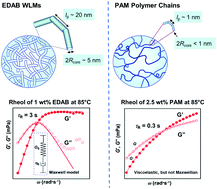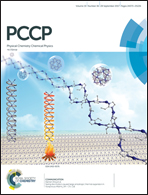Wormlike micelles versus water-soluble polymers as rheology-modifiers: similarities and differences†
Abstract
Wormlike micelles (WLMs) formed from surfactants have attracted much attention for their ability to thicken water in a manner similar to water-soluble polymers. It is known that WLMs are cylindrical filaments that can attain very long contour lengths (∼few μm), akin to chains of polymers with ultra-high molecular weights (UHMWs). In this study, we aim to make a direct comparison between the thickening capabilities of WLMs and UHMW polymers. The chosen surfactant is erucyl dimethyl amidopropyl betaine (EDAB), a C22-tailed zwitterionic surfactant known to form particularly long WLMs independent of salt. The chosen polymer is nonionic polyacrylamide (PAM) having an UHMW of 12 MDa. Both EDAB WLMs and the PAM show strong thickening capability in saline water at 25 °C, but the WLMs are more efficient. For example, a 1.0 wt% EDAB WLM sample has a similar zero-shear viscosity η0 (∼40 000 mPa s) to a 2.5 wt% PAM solution. When temperature is increased, both samples show an exponential reduction in viscosity, but the WLMs are more sensitive to temperature. Microstructural differences between the two systems are confirmed by data from small-angle neutron scattering (SANS) and cryo-transmission electron microscopy (cryo-TEM). As expected, the key differences are that the WLM chains have a larger core radius (Rcore) and in turn, a longer persistence length (lp) than the PAM chains.

- This article is part of the themed collection: Surface chemistry and interface science


 Please wait while we load your content...
Please wait while we load your content...